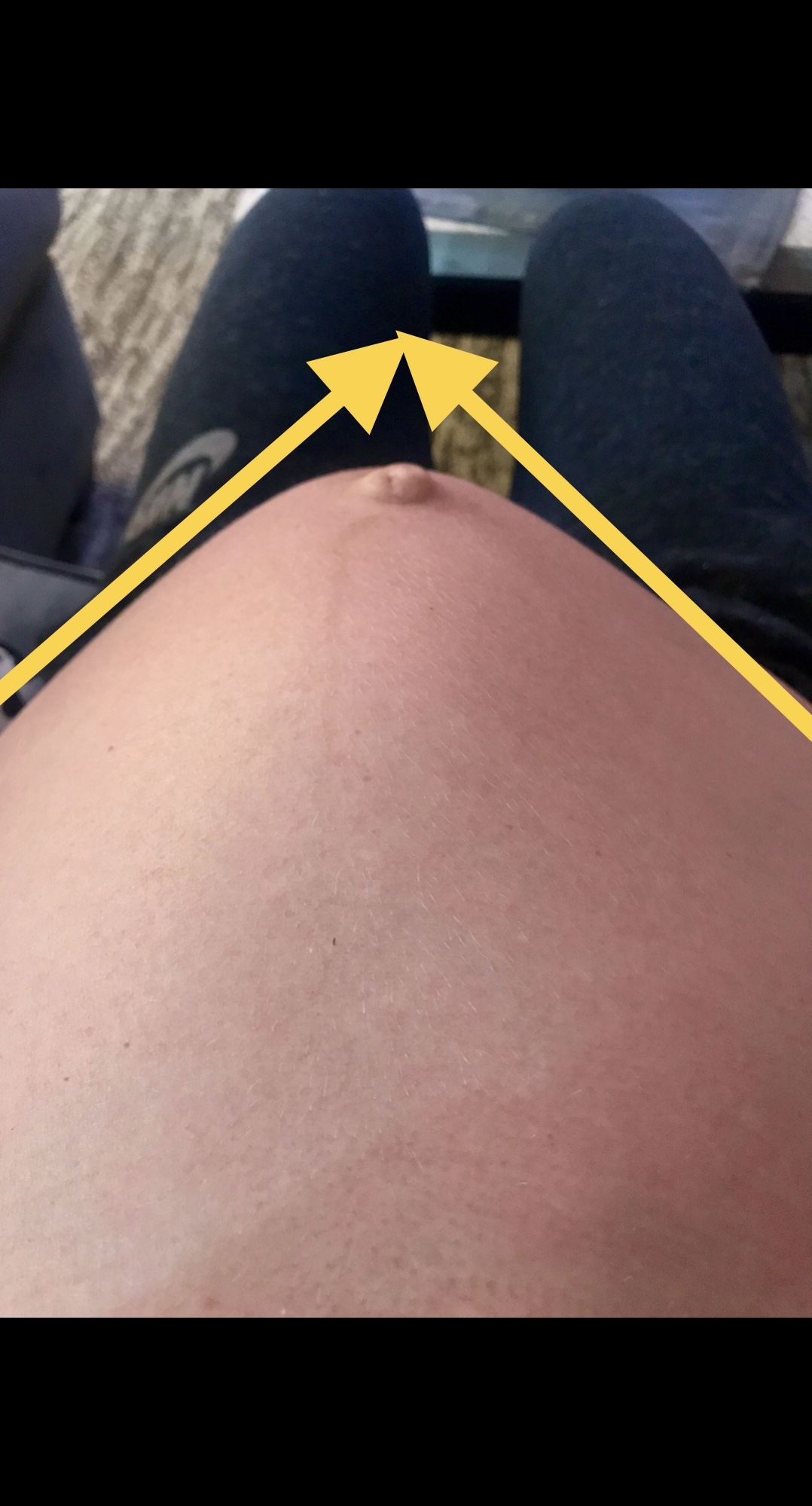Second Trimester: Workout Modifications

My first trimester, while a bit touch and go, did not require me to modify my workouts other than changes in the load here and there. At the start of my second trimester, I realized significant changes would be needed to not only prioritize my immediate health but prevent problems in my recovery post-partum. As with anything in your pregnancy, you have to talk with your practitioner to make sure you’re putting yourself, your health, and your baby first. Really, during this time nothing else matters. My doctor cleared me (and encouraged me) to continue exercising.
Identifying Coning
Coning, or a ridge or bulge down the midline of the belly, typically occurs when doing an exercise that causes the uterus to apply stress on the abdominals. It’s not attractive and should be avoided entirely while pregnant to prevent diastasis recti.

Coning caused by sitting up on the couch. I’m not even exercising! Fahk.
Also, wondering if I should submit this photo for an award of some sort. It’s so well lit and really aesthetically pleasing…
Avoiding Coning
A pregnant belly should stay as round and smooth as possible across your entire stomach in and out of the gym. Avoid crunches, all frontal varieties of planks, push ups, pull ups or chin ups, and any other drill that pushes your belly into a ridge as it can lead to premature separation. Depending on how severe your coning is, twisting and rotational exercises should be removed from your regimen until your core is strong enough to reintroduce them.
Instead, focus on full core activation, and total body functional training which will indirectly engage your abs such as squats, deadlifts, and overhead lifts. Although you have to be careful with overhead lifting, if you go too heavy coning will inevitably happen.
Practicing Deep Core Activation
Your deep core includes your pelvic floor, as well as your transverse abdominals. Activation of the entire canister, at the primary level, happens with diaphragmic breathing.
- Lay down or sit up straight and relax your entire body
- Exhale as you lift and pull up the center of your body (including your lungs) by drawing the front and back of your pelvic floor together. It’ll feel similar to a Kegel exercise
- As you lift and hold, pull your belly inward and upward and wrap your obliques around your stomach. If you’re pregnant, think about hugging your baby with your side body
- Hold on to the lifting sensation while you breathe in and out
- Release completely – your breath and pelvic floor so you can start again
As a result, the muscles in your pelvic floor and abdominals will activate on their own and is the best way to keep your abdominals engaged.
Modifying Overhead Lifts
Many resources will say to avoid overhead lifts in pregnancy, but I believe from personal experience (and so do many others) that information is outdated. As long as any overhead movement doesn’t put stress on your abs or lower back or cause a significant loss of balance, I don’t think there’s any reason to avoid them.
If you’re feeling cautious try these modifications:
- Use dumbbells instead of machinery or a long barbell to help you maintain your balance
- Lower the weight, lifting 50-70% of your average max
- Avoid slower movements that require you to keep the weight overhead
Minimize progressive overloads (gradually adding on to your weight as you progress through a training program). If you’re looking for a challenge, I would suggest adding more reps or playing with your tempo.
Adjusting to Your New Center of Gravity
As your belly starts to grow your center of gravity starts to shift leaving you to feel off balance and usually with lower back pain as the pelvis naturally rolls forward into an anterior tilt. With that anterior tilt your hip flexors, parts of your quads, and the muscles in your lower back end can shorten and tighten. In opposition, your glutes, hamstrings, and parts of your abdominals will lengthen and be underutilized.
It’s essential to stretch and lengthen your hip flexors and engage your glutes and hamstrings through
- Squats. Literally my BFF RN
- Deadlifts
- Lateral band walks
- Forward lunges
- Upper body strength drills – rows, bicep curls, tricep extensions, etc.
These strength building and mobility drills can help avoid any discrepancies from the front of your body to the back, as well as help you prevent lower back pain and improve coordination.
Running Modifications
FIRST OF ALL, if you were not a runner before pregnancy, don’t attempt to become one now, there are so many other forms of cardiovascular activity you could do that has the same benefit. Running seems like something that’s second nature for our bodies, but a running economy is super technical and can lead to a plethora of injuries.
If you ARE a runner, your speed will naturally decline, and your running form will change as your baby grows. But despite slowing down the pace, your level of fitness may improve because of an increase of endurance in your heart and muscular strength, as well as the rate of oxygen delivery from your body to your heart. These systems are in overdrive as you run for TWO!
Regardless of your proficiency, a growing belly will cause the same pelvic tilt detailed above. Consequentially, your back may sway, and one side of your body will strike the ground harder than the other
- Focus less on mileage or speed and more on heart rate – follow a HIIT protocol by driving your heart rate up followed by periods of recovery
- Alternate between running and walking periods to maintain form
- Implement the same core engagement detailed above
Other Tips for Fitness Modifications
- When cycling, raise the handlebars. Leaning forward gets harder and more uncomfortable the more prominent your belly gets. Having higher handlebars brings them closer to your body so your chest and back can stay more erect
- Unheated, prop-based yoga can help you clear your mind, reflect and remain present. It also will help with circulation if you’re feeling inflamed, swollen, or puffy.
- If you haven’t prioritized a healthy lifestyle before getting pregnant, you CAN start during your pregnancy. With clearance from your practitioner, at the very least you can walk, do the elliptical or engage in other light and moderate exercise.
- As your pregnancy progresses, your body produces relaxin to prepare your body for labor which makes you lose your balance and an increase in flexibility (giving you a false sense of your range of motion). Be mindful of this!
Regardless of how you choose to prioritize your fitness throughout pregnancy studies show that babies of women who exercise have healthier prenatal environments. Babies of active mothers throughout their gestation feel less stress and receive more nutrients, and receive more oxygen.
There is so much fear based conversation within the pregnant fitness industry, and as a result, it’s easy to stop working out for fear of hurting your baby or yourself. AGAIN, with clearance from your doctor, keep at it. You’ll be so glad you did!








Responses